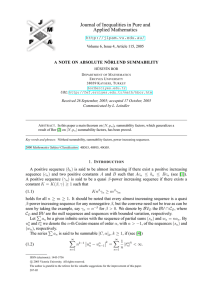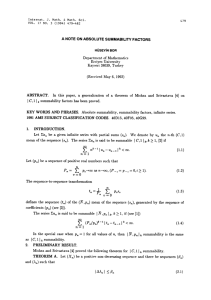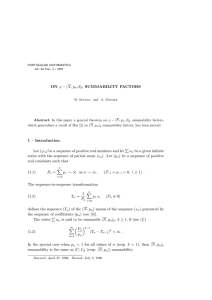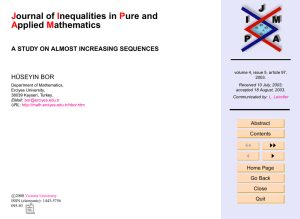ON QUASI Received 31 January, 2008; accepted 15 May, 2009
advertisement
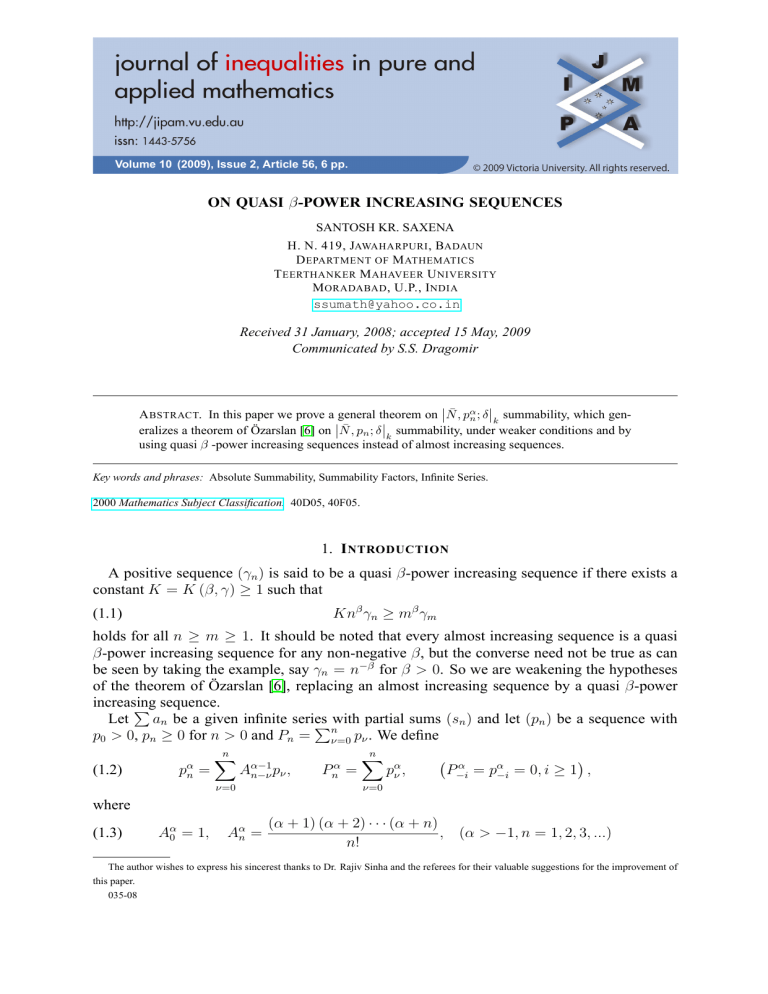
Volume 10 (2009), Issue 2, Article 56, 6 pp. ON QUASI β-POWER INCREASING SEQUENCES SANTOSH KR. SAXENA H. N. 419, JAWAHARPURI , BADAUN D EPARTMENT OF M ATHEMATICS T EERTHANKER M AHAVEER U NIVERSITY M ORADABAD , U.P., I NDIA ssumath@yahoo.co.in Received 31 January, 2008; accepted 15 May, 2009 Communicated by S.S. Dragomir A BSTRACT. In this paper we prove a general theorem on N̄ , pα n ; δ k summability, which generalizes a theorem of Özarslan [6] on N̄ , pn ; δ k summability, under weaker conditions and by using quasi β -power increasing sequences instead of almost increasing sequences. Key words and phrases: Absolute Summability, Summability Factors, Infinite Series. 2000 Mathematics Subject Classification. 40D05, 40F05. 1. I NTRODUCTION A positive sequence (γn ) is said to be a quasi β-power increasing sequence if there exists a constant K = K (β, γ) ≥ 1 such that Knβ γn ≥ mβ γm (1.1) holds for all n ≥ m ≥ 1. It should be noted that every almost increasing sequence is a quasi β-power increasing sequence for any non-negative β, but the converse need not be true as can be seen by taking the example, say γn = n−β for β > 0. So we are weakening the hypotheses of the theorem of Özarslan [6], replacing an almost increasing sequence by a quasi β-power increasing P sequence. Let an be a given infinite series P with partial sums (sn ) and let (pn ) be a sequence with p0 > 0, pn ≥ 0 for n > 0 and Pn = nν=0 pν . We define (1.2) pαn = n X Aα−1 n−ν pν , ν=0 Pnα = n X pαν , α P−i = pα−i = 0, i ≥ 1 , ν=0 where (1.3) Aα0 = 1, Aαn = (α + 1) (α + 2) · · · (α + n) , n! (α > −1, n = 1, 2, 3, ...) The author wishes to express his sincerest thanks to Dr. Rajiv Sinha and the referees for their valuable suggestions for the improvement of this paper. 035-08 2 S ANTOSH K R . S AXENA The sequence-to-sequence transformation n 1 X α p sν = α Pn ν=0 ν Unα (1.4) defines the sequence (Unα ) of the N̄ , pαn mean of the sequence (sn ), generated by the sequence of coefficientsP(pαn ) (see [7]). The series an is said to be summable N̄ , pαn k , k ≥ 1, if (see [2]) ∞ α k−1 X Pn k α (1.5) Unα − Un−1 < ∞, α p n n=1 and it is said to be summable N̄ , pαn ; δ k , k ≥ 1 and δ ≥ 0, if (see [7]) ∞ α δk+k−1 X Pn k α (1.6) Unα − Un−1 < ∞. α pn n=1 In the special case when δ = 0, α = 0 (respectively, pn = 1 for all values of n) N̄ , pαn ; δ k summability is the same as N̄ , pn k (respectively |C, 1; δ|k ) summability. Mishra and Srivastava [4] proved the following theorem for |C, 1|k summability. Later on Bor [3] generalized the theorem of Mishra and Srivastava [4] for N̄ , pn k summability. Quite recently Özarslan [6] has generalized the theorem of Bor [3] under weaker conditions. For this, Özarslan [6] used the concept of almost increasing sequences. A positive sequence (bn ) is said to be almost increasing if there exists a positive increasing sequence (cn ) and two positive constants A and B such that Acn ≤ bn ≤ Bcn (see [1]). Obviously every increasing sequence is an almost increasing sequence but the converse needs not be true as can be seen n from the example bn = ne(−1) . Theorem 1.1. Let (Xn ) be an almost increasing sequence and the sequences (ρn ) and (λn ) such that the conditions (1.7) |∆λn | ≤ ρn , (1.8) ρn → 0 as n → ∞, |λn | Xn = O (1) , (1.9) ∞ X (1.10) as n → ∞, n |∆ρn | Xn < ∞. n=1 are satisfied. If (pn ) is a sequence such that the condition Pn = O (npn ) , (1.11) as n → ∞, is satisfied and (1.12) δk−1 m X Pn n=1 pn |sn |k = O (Xm ), J. Inequal. Pure and Appl. Math., 10(2) (2009), Art. 56, 6 pp. as m → ∞, http://jipam.vu.edu.au/ O N Q UASI β-P OWER I NCREASING S EQUENCES ) ( δk−1 ∞ δk X Pn 1 Pν 1 =O , p P p P n n−1 ν ν n=ν+1 (1.13) then the series 3 P an λn is summable N̄ , pn ; δ k for k ≥ 1 and 0 ≤ δ < k1 . 2. M AIN R ESULT The aim of this paper is to generalize Theorem 1.1 for N̄ , pαn ; δ k summability under weaker conditions by using quasi β-power increasing sequences instead of almost increasing sequences. Now, we will prove the following theorem. Theorem 2.1. Let (Xn ) be a quasi β-power increasing sequence for some 0 < β < 1 and the sequences (ρn ) and (λn ) such that the conditions (1.7) – (1.10) of Theorem 1.1 are satisfied. If α pn is a sequence such that Pnα = O (npαn ) , (2.1) as n → ∞, is satisfied and m α δk−1 X P (2.2) n=1 |sn |k = O (Xm ), as m → ∞, ( ) ∞ α δk−1 δk X Pn 1 Pνα 1 =O , α pαn Pn−1 pαν Pνα n=ν+1 (2.3) then the series n α pn P an λn is summable N̄ , pαn ; δ k for k ≥ 1 and 0 ≤ δ < k1 . Remark 1. It may be noted that, if we take (Xn ) as an almost increasing sequence and α = 0 in Theorem 2.1, then we get Theorem 1.1. In this case, conditions (2.1) and (2.2) reduce to conditions (1.11) and (1.12) respectively and condition (2.3) reduces to (1.13). If additionally δ = 0, relation (2.3) reduces to ∞ X pn 1 (2.4) =O , P P Pν n=ν+1 n n−1 which always holds. We need the following lemma for the proof of our theorem. Lemma 2.2 ([5]). Under the conditions on (Xn ), (βn ) and (λn ) as taken in the statement of the theorem, the following conditions hold (2.5) (2.6) nρn Xn = O (1) , ∞ X as n → ∞, ρn Xn < ∞. n=1 P Proof of Theorem 2.1. Let (Tnα ) be the N̄ , pαn mean of the series an λn . Then by definition, we have n ν n 1 X αX 1 X α α α Tn = α pν aw λ w = α Pn − Pν−1 aν λ ν . Pn ν=0 w=0 Pn ν=0 J. Inequal. Pure and Appl. Math., 10(2) (2009), Art. 56, 6 pp. http://jipam.vu.edu.au/ 4 S ANTOSH K R . S AXENA Then, for n ≥ 1, we get Tnα − α Tn−1 n pαn X α = α α P aν λ ν . Pn Pn−1 ν=1 ν−1 Applying Abel’s transformation, we have α Tnα − Tn−1 = n−1 pαn X pαn α ∆ P λ s + s λ ν ν−1 ν α α n n Pnα Pn−1 P n ν=1 n−1 n−1 pαn X α pαn X α pαn =− α α p s ν λν + α α P sν ∆λν + α sn λn Pn Pn−1 ν=1 ν Pn Pn−1 ν=1 ν Pn α α α = Tn,1 + Tn,2 + Tn,3 , say. Since α α α Tn,1 + Tn,2 + Tn,3 k ≤ 3k α Tn,1 k α + Tn,2 k α + Tn,3 k , to complete the proof of Theorem 2.1, it is sufficient to show that ∞ α δk+k−1 X P n=1 n pαn α Tn,w k < ∞, for w = 1, 2, 3. Now, when k >1, applying Hölder’s inequality with indices k and k 0 , where using |λn | = O X1n = O (1), by (1.9), we have m+1 X n=2 Pnα pαn δk+k−1 α k Tn,1 = m+1 X n=2 ≤ m+1 X Pnα pαn δk+k−1 Pnα pαn δk−1 n−1 pαn X α p ν s ν λν α Pnα Pn−1 ν=1 1 pαν |sν |k |λν |k + 1 k0 = 1, and k 1 n−1 X α Pn−1 n=2 ν=1 ν=1 m m+1 δk−1 X X Pα 1 k k n α = O (1) pν |sν | |λν | α pαn Pn−1 ν=1 n=ν+1 α δk m X Pν 1 k k α = O (1) pν |sν | |λν | α pν Pνα ν=1 m α δk−1 X Pν = O (1) |sν |k |λν |k α p ν ν=1 m X P α δk−1 ν = O (1) |sν |k |λν | |λν |k−1 α p ν ν=1 m X P α δk−1 ν = O (1) |sν |k |λν | α p ν ν=1 J. Inequal. Pure and Appl. Math., 10(2) (2009), Art. 56, 6 pp. α Pn−1 n−1 X 1 k !k−1 pαν http://jipam.vu.edu.au/ O N Q UASI β-P OWER I NCREASING S EQUENCES m−1 X = O (1) ∆ |λν | ν α δk−1 X P ν=1 u=1 m−1 X = O(1) u pαu k |su | + O (1) |λm | 5 m α δk−1 X P ν pαν ν=1 |sν |k |∆λν | Xν + O (1) |λm | Xm ν=1 = O (1) m−1 X ρν Xν + O (1) |λm | Xm ν=1 as m → ∞, = O (1) , 1 Xν = O (1) , by by virtue of the hypotheses of Theorem 2.1 and Lemma 2.2. Since νρν = O α α (2.5), using the fact that |∆λn | ≤ ρn by (1.7) and Pn = O (npn ) by (2.1) and after applying the Hölder’s inequality again, we obtain m+1 X n=2 ≤ Pnα pαn m+1 X n=2 ≤ m+1 X n=2 = O (1) = O (1) δk+k−1 δk−1 Pnα pαn Pn pαn k (X n−1 1 α Pn−1 m X ν=1 m X m−1 X δk−1 ∆ (νρν ) )( pαν k m+1 X (νρν ) |sν | 1 n−1 X α Pn−1 ν=1 k α δk−1 Pn pαn )k−1 pαν 1 α Pn−1 (νρν )k |sν |k ν α δk−1 X P w=1 m−1 X Pνα |∆λν | |sν | ν=1 n=ν+1 Pνα pαν )k ν=1 pαν (νρν )k |sν |k ν=1 = O (1) k α Pn−1 ( n−1 X 1 α δk−1 ν=1 = O (1) α Tn,2 w pαw k |sw | + O (1) mρm m α δk−1 X P ν ν=1 pαν |sν |k |∆ (νρν )| Xν + O (1) mρm Xm ν=1 = O (1) m−1 X ν |∆ρν | Xν + O (1) ν=1 = O (1) , m−1 X ρν+1 Xν+1 + O (1) mρm Xm ν=1 as m → ∞, by the virtue of the hypotheses of Theorem 2.1 and Lemma 2.2. Finally, using the fact that α Pnα = O (npαn ) , by (2.1) as in Tn,1 , we have m α δk+k−1 X P n=1 n pαn α k Tn,3 = O (1) m α δk−1 X P n n=1 = O (1) , J. Inequal. Pure and Appl. Math., 10(2) (2009), Art. 56, 6 pp. pαn |sn |k |λn | as m → ∞. http://jipam.vu.edu.au/ 6 S ANTOSH K R . S AXENA Therefore, we get ∞ α δk+k−1 X P n=1 n pαn α Tn,w k = O (1) , as m → ∞, for w = 1, 2, 3. This completes the proof of Theorem 2.1. If we take pn = 1 and α = 0 for all values of n in Theorem 2.1, then we obtain a result concerning the |C, 1, δ|k summability. R EFERENCES [1] S. ALJANČIĆ (1977), 5–22. AND D. ARANDELOVIĆ, O-regular varying functions, Publ. Inst. Math., 22(36) [2] H. BOR, A note on some absolute summability methods, J. Nigerian Math. Soc., 6 (1987), 41–46. [3] H. BOR, A note on absolute summability factors, Internet J. Math. and Math. Sci., 17(3) (1994), 479–482. [4] K.N. MISHRA AND R.S.L. SRIVASTAVA, On absolute Cesàro summability factors of infinite series, Portugal. Math., 42(1) (1985), 53–61. [5] L. LEINDLER, A new application of quasi power increaseing sequences, Publ. Math. (Debrecen), 58 (2001), 791–796. [6] H.S. ÖZARSLAN , On almost increasing sequences and its applications, Internat. J. Math. and Math. Sci, 25(5) (2001), 293–298. [7] S.K. SAXENA AND S.K. SAXENA, A note on N̄ , pαn ; δ 33(4) (2007), 829–834. J. Inequal. Pure and Appl. Math., 10(2) (2009), Art. 56, 6 pp. k summability factors, Soochow J. Math., http://jipam.vu.edu.au/

